Regional economy. Рубрика в журнале - Economic and Social Changes: Facts, Trends, Forecast
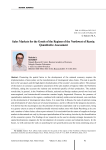
Sales markets for the goods of the regions of the northwest of Russia: quantitative assessment
Статья научная
Promoting the spatial factor in the development of the national economy requires the implementation of state policy on the transformation of interregional value chains. This task is specific due to the vast spaces and the high degree of polarization of the country’s economic sphere. The purpose of the study is to conduct a quantitative assessment of the sales markets of regions within the Northwest of Russia, taking into account the industry and territorial specifics of their production. The analysis reveals that, in general, in the Northwest of Russia, national and foreign markets prevail over local and macroregional, and interterritorial interaction remains largely fragmented. However, the presence of specialization industries in the regions, combined with relatively stable external demand, can contribute to the development of interregional value chains. It is noted that in Russia, the tasks of optimal zoning and development of value chains are of crucial importance, and it is reflected in the program documents. It is shown that the macroregion uses the potential of internal cooperation only to a small extent, being to a greater extent an array of multidirectionally oriented market zones with Saint Petersburg as its core and a number of value chains, often export-oriented. It is concluded that the nature of supplies to foreign markets is determined not only by the export specialization of the territory, but also by the diversification of the economic system. The findings of our research can be used to develop strategic documents for spatial development, programs for the development of economic sectors and industrial clusters. In the future, we will continue the work on searching for new growth points and the most promising areas of structural changes for the transition of regions and the country as a whole to sustainable socio-economic development.
Бесплатно

Scientific and technological development of Russia: state assessment and financing problems
Статья научная
Given the current conditions of rapid cyclical economic processes, the urgency of tasks related to ensuring sustainable economic growth is increasing. The available experience clearly indicates that sustainability can only be achieved by ensuring the proper level and pace of scientific and technological development. At the same time, the implementation of spatial development concept is entering into the foreground due to globalization, integration and digital technologies development. The purpose of the work is to assess the scientific and technological development of Russia in the context of international comparisons and to study the system of R&D financing in the country. Based on this purpose, the article considers the evolution of approaches to the scientific and technological development of territories, identifies the need to form a single scientific and technological space in Russia, which will reduce the existing imbalances and ensure the uniformity of regional development; substantiates the significance of the financial subsystem in the formation of a single space; analyzes its state. The conducted analysis has shown that the current system of research and development financing in Russia is contrary to the global trends. The research has revealed that a crucial role in the process of funding is still played by the state; it has demonstrated the low efficiency of the system of R&D financing and offered recommendations for its improving and optimizing, i.e. the formation of regional funds for scientific, scientific-technical and innovation activities; increasing the availability of federal funding sources of scientific and technological development in the regions and the efficiency of venture activity in Russia. Further stages of the research will involve studying other basic subsystems of the scientific and technological space (organizational, managerial, informational, educational, etc.), as well as working out practical recommendations for their development, efficiency and harmonious interaction and functioning.
Бесплатно

Статья научная
The shadow economy is one of the most complex socio-economic phenomena in almost any state. The shadow economy, which has become an integral structural element of an economic system, has a diverse and sometimes ambiguous impact on it. The nature and assessment of this phenomenon and the ways to deal with it have been in the focus of attention of scientists, government authorities, trade unions, and economic entities for a long time. Having reviewed the definitions of the shadow (underground) economy that are suggested by modern domestic and foreign sources, we consider this phenomenon as an economic activity of actors that are hidden from the influence of state control. In this regard, we can highlight the following priority areas of research: identification of factors that have a significant impact on the volume and nature of the shadow economy, development of measures to overcome it, and search for more adequate quantitative methods for its assessment at different levels of public administration. Of particular interest is the regional aspect of the shadow economy, which is not given due attention in publications. The article presents an attempt to compensate for this lack of attention. The aim of the work is to assess the scale of the shadow economy nationwide and in Russia’s individual constituent entities on the basis of generalization of the methods applied and with the use of official statistical information of all- Russian agencies: the Federal State Statistics Service, the Federal Tax Service and their regional offices. Scientific novelty of the study lies in adjusting the traditional approach to the assessment of the shadow economy by the tax method, which consists in eliminating the amount of depreciation deductions from the indicators of gross profit of the economy and gross mixed income. The proposed method has been tested on the economy of Russia and several regions of the Central Federal District. We have revealed significant differences in the estimation of the scale of this phenomenon if various calculation methods are used. We review a set of measures aimed at reducing hidden income at the federal and regional levels, taking into account the current socio-economic situation complicated by the coronavirus pandemic.
Бесплатно

Статья научная
The Russian economy has faced a number of large-scale geopolitical and socio-economic challenges in recent years. At the same time, the territories with single-industry specialization were the most negatively affected, since their town-forming enterprises are highly dependent on external environmental factors. The list of single-industry towns in Russia was formed ten years ago; during this time there have been many global changes, but the authorities are still guided by this document when developing measures of state support. The work had two objectives: first, to assess the degree of their current monoprofile on the basis of analyzing the activities of the main economic entities in singleindustry towns; and second, to identify how the new geopolitical and socio-economic challenges have affected the activities of town-forming enterprises. The research object was 20 small and mediumsized towns of the European North of Russia, categorized as single-industry towns. We identified three groups of towns: 1) single-industry towns with one or several large enterprises in one industry sector (i.e., towns that have retained their monoprofile); 2) single-industry towns that currently have several large or medium-sized enterprises in different economic sectors; 3) former single-industry towns with one or several town-forming enterprises that are currently liquidated. Based on the analysis of the financial performance of enterprises operating in small and medium-sized towns, we found that sanctions and the disruption of production chains with Western countries led to a marked decline in the profits of most of these organizations. The enterprises of the timber industry complex were particularly hard hit, as their activities were more export-oriented. The scientific novelty of the research lies in the development and approbation our own methodological approach to the implementation of the typology of towns classified as single-industry municipalities, based on the analysis of enterprises functioning in them.
Бесплатно

Small business is an important reserve for development of a one company town
Статья научная
The small business development acquires strategic importance for sustained social and economic development of regions, especially for one company towns located on their territories. The composition of problems occurred in one company towns, the factors that create difficult situations in their economic and social and cultural life are considered in the article. The possibilities of using small business for sustainable growth of a one company towns and improving the quality of life of their people in times of crisis and during the post-crisis development are substantiated.
Бесплатно
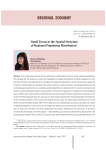
Small towns in the spatial structure of regional population distribution
Статья научная
The article discusses the role of small towns in the spatial structure of the regional population. The purpose for the study is to assess the irregularity of spatial distribution of urban population in the Sverdlovsk Oblast and substantiate the prospects for regional distribution system dynamics by using the methods of mathematical modeling. The author analyzes various domestic and foreign theoretical and methodological approaches to analyzing spatial disparities in deployment of economic potential and human capital throughout regions and countries. The author's approach is to apply the methodological tools of Zipf's law, which proved its effectiveness during the study of urban population dynamics in the works of both foreign and domestic scholars, to study trends and prospects for demographic development in the Sverdlovsk Oblast. The research has helped reveal actual and ideal Zipf's distribution for towns of the Sverdlovsk Oblast during 1989-2015. Based on the methodology the author calculates the values of optimal population in the towns of the Sverdlovsk Oblast in each period and concludes that over the past 25 years the deviation of actual distribution from Zipf's distribution has decreased...
Бесплатно
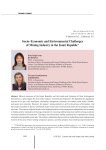
Socio-economic and environmental challenges of mining industry in the Komi Republic
Статья научная
Mineral resources of the Komi Republic and the trends and dynamics of their development determine to a great degree the level of the regions' economic development. The Republic has significant reserves of oil, gas, coal, aluminum, chromium, manganese, titanium, rare metals, gold, barite, fluorite, and quartz raw materials. However, the region's mining industry is still in the process of formation, this fact makes it possible to foresee and handle major social and environmental issues that accompany mining activities. The analysis of global trends in the implementation of mining projects substantiates the necessity to build a positive reputation of mining companies for ensuring stable production and for solving social and economic problems of territories. The paper also determines staffing requirements of prospective mining enterprises and possible social risks. The authors substantiate the necessity to redistribute taxes and payments in favor of the areas where mining companies operate, and they propose ways of attracting investment in mining projects on the stage of exploration with the help of a flexible fiscal policy...
Бесплатно

Статья научная
The article is devoted to the problem of interregional differences in the economic area of the Russian Federation. The research covers a long period (from 1990 to 2020), since this period saw significant changes in the economic, institutional and political structure of the country. The assessment of the level of differences of regions is based on the main socio-economic indicators, data on which are formed in the system of state regional statistics. The Theil index was used as the basic method for measuring inequality. This made it possible to assess the dynamics of the spatial localization of economic activity in terms of the main socio-economic indicators, as well as form the groundwork for continuing the research - assessing its intragroup and intergroup components in the sectoral aspect. For a structural analysis of the problem of regional differences, we propose our own algorithm that allows us to form a discrete variation series and calculate the integral decile coefficient. The numerical implementation of the proposed algorithm made it possible to compile a multidimensional classification of regions according to the level of their economic activity and calculate the decile coefficient on this basis; the decile coefficient integrates the totality of the main socio-economic indicators adopted for the research. The results of the research show the long-term dynamics of the growth of differences and its significant level in comparison with the pre-reform period. A numerical assessment of the measure of differences, measured using the integral decile coefficient for a set of basic economic indicators of the regions, has been compiled. On this basis, it was found that in the long term (1995-2020) the level of economic differences of the regions increased from 2.4 to 5.6 times. A classification of regions according to the level of economic activity has been compiled, which reflects the nature of the differences of the regions of the Russian Federation, as well as the geography of the location of centers of concentration of economic activity.
Бесплатно
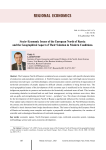
Статья научная
The European North of Russia is considered as an economic region with specific characteristics of production and population settlement. A North European economy type with high natural resource potential, innovative geo- and biotechnologies, telecommunication systems and forms of organization of territorial communities of people adapted to difficult climatic conditions is being formed here. The socio-geographical aspect of the development of this economy type is manifested in the interests of the indigenous population to preserve and modernize the historically reclaimed areas of land. This involves overcoming obstacles in rational land use and forest management, reviving existence near rivers, lakes and sea gulfs, and strengthening territorial “center - periphery” ties. The choice of strategic directions for the development of the European North of Russia is significantly influenced by external conditions. They update topics related to the reaction to the world order transformation, the North Russian identity, the contact zone formation for the continental and maritime economies, food security, and the protection of Russia's Arctic interests from foreign interference threats. The issues of studying the European North of Russia are becoming more complex and require a purposeful scientific explanation, the creation of scientific and technological foundations of territorial management
Бесплатно

Spatial aspects in the development of the small business sector in the region
Статья научная
Using the example of the small business sector, the paper analyzes the specifics of an emerging system for managing the spatial development of the economy in one of the regions of the Russian Federation. This aspect is currently regulated by a whole range of documents at the federal and regional levels, and its features include fragmentation, both vertically and horizontally. Currently, only separate blocks of spatial management processes are identified, which are partially interconnected. The described tasks are regulated by various documents: laws of constituent entities of the Federation, target programs, strategies and concepts for spatial or agglomeration development. The federal level has the Spatial Development Strategy of the Russian Federation for the period up to 2030 with a forecast up to 2036, which takes into account negative reviews of the previous document. The regional level has no unified approach to the development and implementation of spatial development documents as well. In order to substantiate the possibilities for improving strategic management in the spatial development of regions, we solved the following tasks: updating the approach to the consideration of the regional economic space; substantiating individual structural elements of the regional economic space - agglomerations and subregions - as objects of management; substantiating the possibilities of a strategic approach to managing the spatial development of the region's economy; analyzing best practices of sub-regional management in the regions; and substantiating practical recommendations to authorities on improving the regional management system at the sub-regional level
Бесплатно

Spatial management of the shipping routes in the Russian Arctic
Статья научная
The new plans for Russian Arctic development are predetermined by changes in the external economic environment and the state’s internal policy. In May 2018, Russian President Vladimir Putin announced new development guidelines for the Northern Sea Route. Later on, the documents related to the strategic development of the Russian Arctic zone were approved. In these documents, the Northern Sea Route development is highlighted as one of the main directions of competitive national transport communication of the Russian Federation on the global market. The purpose of the research is to determine the role of the Northern Sea Route in the country’s spatial and socio-economic development in the context of the Spatial Development Strategy of the Russian Federation until 2025. The long-term plans launched various economic, political, and other socially significant processes in the Russian Arctic, which led to the formulation of two research tasks. The first one is to consider the main approaches to the spatial management of the regional economy and to present the implementation of the spatial economy provisions in case of the Northern Sea Route that is the center of the Arctic space “assembly”. The second one is to reveal the Northern Sea Route potential as a transport and logistics highway in the transit traffic area, transportation of raw materials, and ensuring vital activity of the population of the Northern regions in deliveries of goods to the Northern territories. As a result of the research, the authors have identified the main trends in the NSR development: strengthening of Russia’s domestic economic policy, aimed at activating business processes in the Arctic zone of the Russian Federation, and the usage of the NSR as an international transit highway. Data analysis on transportation of raw materials and goods deliveries to the Northern territories indicates that inland navigation will soon be a dominant type of navigation on the Northern Sea Route.
Бесплатно
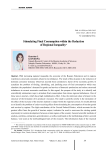
Stimulating final consumption within the reduction of regional inequality
Статья научная
With increasing regional inequality, the economy of the Russian Federation and its regions experiences structural constraints related to its imbalance. The result of this situation is the reduction of domestic consumer demand, which has recently been considered a factor of the economic growth. It actualizes the problem of finding, identifying, and justifying areas of final consumption which may stimulate the population’s demand for goods and services of domestic production and reduce structural imbalances in current economic conditions. In this regard, the purpose of the study is to identify and scientifically substantiate ways to stimulate final consumption that reduce regional imbalances. One of these ways is tourism, which has a high multiplicative effect. It has the minimum share of import in the structure of the formation of its products’ resources. The study’s scientific novelty is the estimation of the effect of the increase of the tourism industry’s output within the regional context. Its results allowed us to identify the problem of under-receiving effects from stimulating the consumption of tourism goods and services by regions. The high contribution of the Central Federal District, which accounts for the greatest effect from the growth of tourism output, indicates the need to overcome the existing spatial asymmetry in tourism development between certain regions of the country. General scientific methods of analysis, synthesis, comparison, generalization, as well as tools based on the methodology of inter-sectoral balance, were used as the methodological basis of the research. The information basis of the research included works of domestic and foreign scientists dealing with structural policy, information from state statistics institutions, data from the World Bank and the World Tourism Organization. Future research areas are related to the definition of methods for regulating final consumption for a deeper understanding of problems of economic restructuring.
Бесплатно

Strategic classification of regions according to the level of financial self-sufficiency
Статья научная
In the context of highly uneven regional development, subnational and federal governments are facing an extremely important task of elaborating and implementing the strategy for development of Russia's constituent entities. In this regard the research on financial self-sufficiency of regions as a driver of resource security of strategic development becomes an urgent issue. The goals of our study include building a typology of regions according to the level of financial self-sufficiency and identifying strategizing features for individual groups of regions. Cluster analysis, principal component analysis and panel data analysis are used to achieve the goals. In order to build sustainable groups, we form a system of 18 indicators of financial self-sufficiency of regions; we carry out cluster analysis on its basis; after that, we identify three groups of regions: leaders, average performers, and outsiders. This classification of regions can be considered stable, since the composition of the groups has not changed over time. We carry out the principal component analysis using our set of indicators of financial self-sufficiency and identify three generalizing factors that characterize the budgetary security of the regions, the potential of regional and municipal taxes, and the tax burden on the economy. We carry out modeling with the use of panel regression and analyze the influence of each factor on financial self-sufficiency in each group of regions. The resulting classification has significant scientific prospects regarding the formation of a general strategizing methodology for regions with different levels of financial self-sufficiency. The strategic classification can be used by regional authorities to form regional and sectoral development strategies.
Бесплатно

Статья научная
At present, Russia's economy is dependent on import in some of its strategically important sectors. The recent economic and political developments such as the aggravation of geopolitical situation and termination of economic partnership between Russia and a number of countries and entities, and also the Government's policy that aims to reduce import dependence determine the need to expand the interaction between domestic producers and the need to use domestic resources, materials and equipment in economic activities. Import substitution in Russia can become a driving force of its industrial growth. The paper presents different interpretations of the term “import substitution” contained in several publications of recent years; it also reveals a common approach of the authors to this problem. The article summarizes existing proposals on priority areas of import substitution such as the shift towards import-substituting production and technology in strategically important industries...
Бесплатно

Strategic priorities for the Russian seaports cargo turnover structure development
Статья научная
Trends in the world economy and trade, as well as the process of globalization, contribute to the seaports development as a strategic driver of economic growth in many countries. Seaports play a major role in optimizing trade relations; they act as key nodes in global transport chains and serve as connecting elements of the socio-economic systems in many countries. We have identified global, national and regional trends in the development of port facilities, analyzed cargo transshipment in the sea ports that are strategic objects of the state; this determines the need to improve methods and forms of management of their development on the basis of advanced technology. The development of port infrastructure will ensure economic growth both in the regional location and in the country as a whole. It is in the regions that it is necessary to form a competitive environment for economic entities, in particular seaports. Their development should have a positive impact on economic and social aspects: economic growth of territorial entities, market competition, development of innovative technologies and investment inflow. Empirical estimates of the links of neighboring regions economic growth were obtained on the basis of Moran's I, as well as from studies on how Russia's export cargo flows through seaports depend on GDP and on the index of industrial production in the period from 2006 to 2018. We analyzed the relationship between cargo turnover and shocks such as the financial and economic crisis of 2008-2009 and the imposition of sanctions, which for obvious reasons increase the observed volatility of international trade and, in particular, cargo volumes in ports. In the conclusion of the article we have formulated strategic priorities for the development of cargo turnover structure in sea ports on the basis of the identified opportunities and the obtained forecasts.
Бесплатно
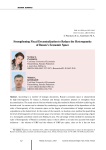
Strengthening fiscal decentralization to reduce the heterogeneity of Russia's economic space
Статья научная
According to a number of strategic documents, Russia’s economic space is characterized by high heterogeneity. To reduce it, Russian and foreign researchers propose to strengthen fiscal decentralization. The study aims to find out whether using this method in Russia will allow achieving the desired result. An answer can be obtained by conducting a regression analysis of the dependence of the scale of heterogeneity of the economic space on the degree of concentration of budget revenues and expenditures at the federal level. In the course of the research, we develop a new method for quantifying the level of heterogeneity of the economic space of a territory; the method requires constructing a figure in a rectangular coordinate system and finding its area. The advantage of this method for assessing the scale of heterogeneity of Russia’s economic space is that it allows us to take into account both major indicators - the volume of GRP and the volume of GRP per capita, since so far it has not been determined which of them is a numerical indicator of a region’s economic development level. Having assessed the scale of heterogeneity of Russia’s economic space for the period from 2000 to 2021 with the help of the above method, we conclude that strengthening fiscal decentralization will reduce the heterogeneity of Russia’s economic space. In particular, a 1% decrease in the concentration of budget expenditures at the federal level may lead to a 12.6% decrease in heterogeneity. Proceeding from this conclusion, we put forward some ways to reduce the share of federal budget expenditures in the total volume of the expenditure part of the consolidated budget.
Бесплатно

Structure and dynamics of household consumption of information goods: regional perspective
Статья научная
Over the past two decades, the indicators of consumption of information goods by the Russian population have been significantly behind the similar indicators in developed countries, which was accompanied by inequality in consumption between Russian regions. The importance of studying consumption of information goods in information economy is due to the fact that the degree of satisfactionofneedsreflectsthelevelofpopulation'swelfareandisanindicatorofinnovativedevelopment which defines the incentives and constraints of modernization and long-term sustainable growth of the national economy. The article is devoted to contemporary structural changes in consumption of auxiliary information goods by the population of a dynamically developing region (the Sverdlovsk Oblast) amid the development of information economy. The use of methods of economic-statistical analysis and sociological survey has helped identify the structure and main trends in consumption of information goods in Russia in general and in the Sverdlovsk Oblast in particular. The article reviews the impact of factors such as consumers' age group, place of residence (town, village) and income level on household consumption of goods in the Sverdlovsk Oblast.
Бесплатно

Статья научная
The relevance and significance of the study are determined by the following: the analysis of international and Russian practices of establishing borders of the Arctic zone, trends and their changes observed in recent years in Russia, the study of the characteristics of economic activity in the Arctic, the adoption of the federal law to support business activities in the Arctic zone of the Russian Federation. The purpose of the work is to substantiate the inclusion of a number of such municipalities of the Magadan Oblast as Severo-Evensky, Omsukchansky, Srednekansky and Susumansky urban districts in the Arctic zone of the Russian Federation. The reason is the similarity of their natural, climatic and geographical characteristics with the Arctic regions, identity of the socio-economic development problems, unity of the Magadan Oblast municipalities and the Arctic regions of the Far Eastern Federal District by a common infrastructure. Scientific novelty of the study lies in proving the homogeneity of the conditions of the Magadan Oblast districts and the Arctic regions using the selected criteria. On the example of the project on the development of the Omolon iron-ore cluster, we assessed the effectiveness of its implementation for investors, considering the measures of state support in the Arctic zone of the Russian Federation. Thus, resource savings for the investor, taking into account the Arctic benefits, are more than twice as much as the savings from the use of the preferential economic zone regime in the Magadan Oblast. The research findings formed the basis of the expert conclusion on the expediency of inclusion of a part of the territory of Magadan Oblast into the Arctic zone of the Russian Federation, which will help create favorable conditions for investors in the development of natural resource potential, as well as ensure socio-economic development of the entire region.
Бесплатно
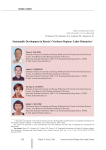
Sustainable development in Russia's northern regions: labor dimension
Статья научная
The article points out that sustainable development is not the ultimate goal, but a dynamic process of adaptation, cognition and activity. We show that the transition to sustainable development is preconditioned by historical circumstances; we reveal the chronology of the concepts of sustainable development from the Brundtland Report to the 2030 Agenda. We analyze six international systems of sustainable development indicators; each of the systems contains social-labor indicators and indicators of living standards. We emphasize that the common disadvantage of all the systems is that their indicators are poorly adapted to Russian statistics. We consider it important to establish a set of labor indicators and develop a methodology to assess sustainable development. The novelty of our research lies in fact that we use our own approach to the assessment of sustainable development with the use of labor indicators. Labor stability is estimated according to four factors that include twelve labor indicators...
Бесплатно
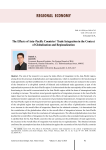
Статья научная
The aim of the research is to assess the trade effects of integration in the Asia-Pacific region, arising from the processes of globalization and regionalization, which is manifested in the functioning of trade agreements and their proliferation. It is shown that mutual trade barriers are reduced in the context of the formation of a sub-global network of bilateral and multilateral trade agreements as part of the regionalization process in the Asia-Pacific region. It is determined that the vast majority of free trade zones functioning in the world is concentrated in the Asia-Pacific region while the share of intraregional trade is tending to increase. The authors reveal general regularities of integration processes in the Asia-Pacific region based on the decomposition assessment of the effects of trade agreements in the framework of a synthesized modern approach to the assessment of gravitational dependencies. Integration processes in the Asia-Pacific region in the long term have been generating the effect of creating trade for the countries of the sub-global region that concluded trade agreements, and the effect of globalization contributed to an increase in the overall effect of integration. Based on the obtained estimates, it is determined that the contribution of the globalization effect to the overall effect of integration between the Asia-Pacific countries was higher than from the conclusion of trade agreements. The effects of globalization more than doubled the overall effect of integration for the Asia-Pacific countries that concluded trade agreements. It is clarified that for the Asia-Pacific countries that are carrying out the proliferation of trade agreements, the increase in the overall effect of integration was mainly due to regionalization. The obtained estimate confirmed the assumption that there is discrimination against the economies of the Asia-Pacific countries that do not expand the geography of concluded trade agreements in the region. Based on the obtained estimates, it is argued that the effective strategy for Russia is to increase the coverage of the Asia-Pacific countries to conclude trade agreements in order to diversify foreign trade and support export-oriented sectors of the economy.
Бесплатно

